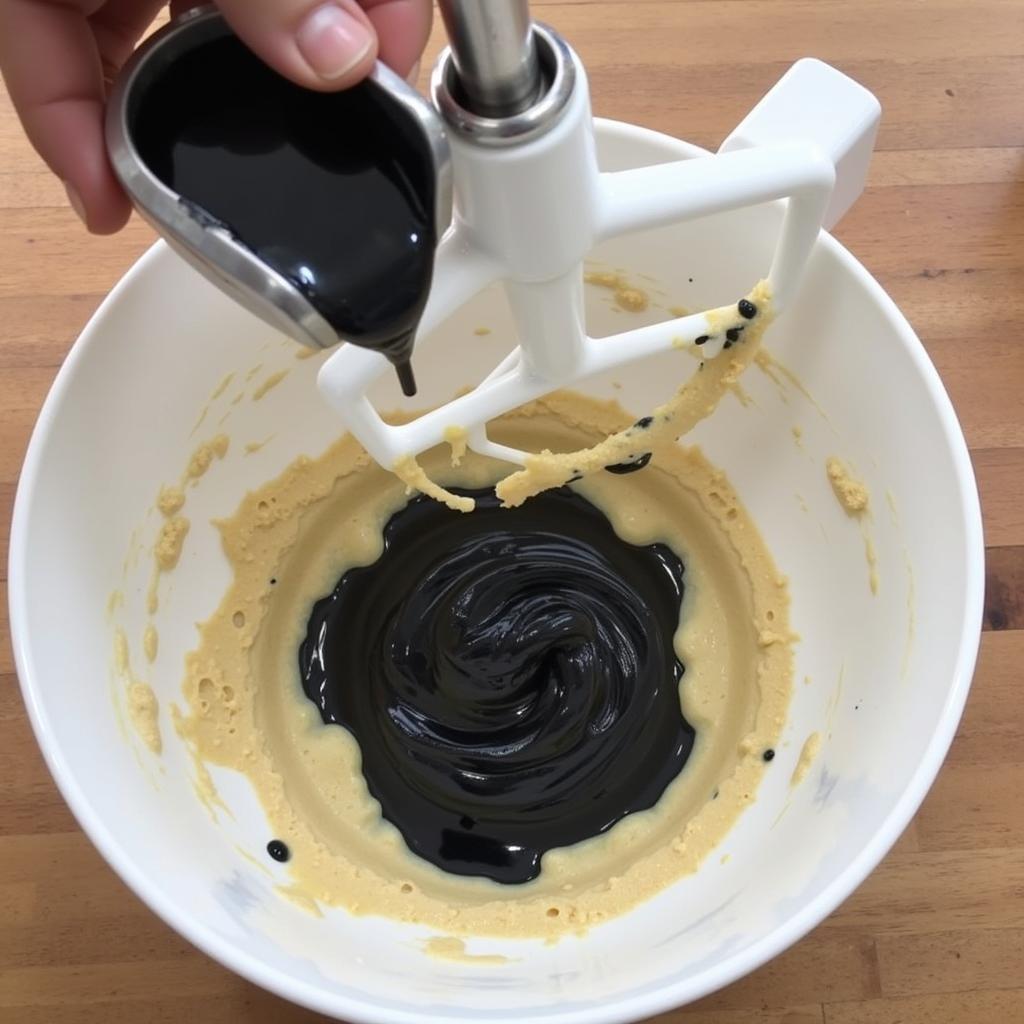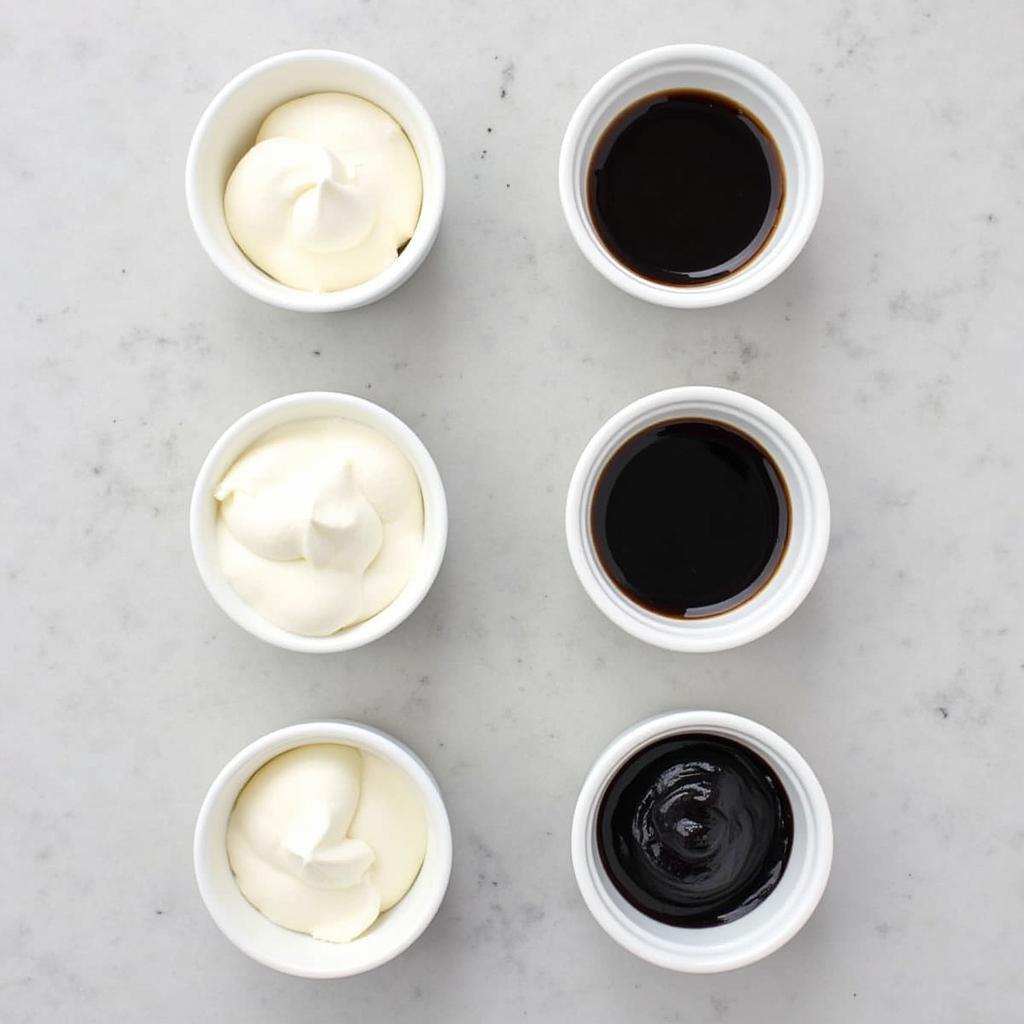Black Oil Based Food Coloring is a powerful tool for achieving rich, deep black hues in your culinary creations. Whether you’re a seasoned baker or a home cook looking to elevate your desserts, understanding how to use this specific type of food coloring can open up a world of possibilities. This guide delves into everything you need to know about black oil based food coloring, from its unique properties to practical tips and troubleshooting. Let’s explore the art of achieving the perfect black.
Understanding Black Oil Based Food Coloring
Black oil based food coloring differs from water-based or gel-based counterparts in its composition and application. Its oil base allows it to disperse evenly in fat-based mediums, making it ideal for coloring chocolate, buttercreams, and other oil-rich recipes. Unlike water-based colorings, which can thin out your mixtures, oil-based colorings maintain the integrity of your ingredients. You can achieve that intense, true black without compromising the texture of your final product. It’s also exceptionally potent, so a little goes a long way. For those venturing into the world of chocolate artistry, check out our guide on the best food color for chocolate.
 Using Black Oil Based Food Coloring in Chocolate Ganache
Using Black Oil Based Food Coloring in Chocolate Ganache
Achieving the Perfect Black: Tips and Tricks
Getting a true black with food coloring can be tricky. Often, you end up with a dark gray or a color with an unwanted undertone. With black oil based food coloring, the key is to start small and build gradually. Begin by adding a tiny drop at a time, mixing thoroughly before adding more. This controlled approach prevents over-coloring and ensures you achieve the desired shade of black. Remember, it’s always easier to add more color than to take it away! For more vibrant colors in other applications, consider exploring options like red food dye powder.
Why Choose Black Oil Based Food Coloring?
The benefits of black oil based food coloring extend beyond its rich color payoff. It also offers excellent stability, meaning your black hues will remain vibrant and won’t fade over time. This makes it perfect for elaborate cake decorations or intricate sugar art. If you’re looking to expand your color palette for sugar art, you might be interested in our sugar art food coloring selection.
 Mixing Black Oil Based Food Coloring into Cake Batter
Mixing Black Oil Based Food Coloring into Cake Batter
Troubleshooting Common Issues
Even with the best techniques, you might encounter some challenges. One common issue is uneven color distribution. This can often be resolved by ensuring your base ingredient is at the right temperature and consistency. If you’re working with chocolate, tempering it correctly is crucial for smooth and even color incorporation.
How Much Black Oil Based Food Coloring Should I Use?
The amount of black oil based food coloring you need depends on the volume and type of your base ingredient. A general rule of thumb is to start with a very small amount and gradually increase until you reach the desired intensity. It’s always best to err on the side of caution, as adding too much can be difficult to correct. Consider creating a food combination chart to keep track of your color experiments and achieve consistent results.
 Varying Shades Created with Black Oil Based Food Coloring
Varying Shades Created with Black Oil Based Food Coloring
“When working with black oil-based food coloring, remember that patience is key,” advises renowned pastry chef, Amelia Dubois. “Take your time, add the color slowly, and you’ll be rewarded with a beautiful, rich black that truly elevates your desserts.”
Exploring Other Black Food Coloring Options
While oil-based colorings excel in fat-based applications, other options exist for different needs. Black food coloring liquid is a versatile choice for a wider range of recipes.
In conclusion, black oil based food coloring is a valuable asset for anyone looking to create stunning black hues in their culinary creations. By understanding its unique properties and following the tips outlined above, you can master the art of using this powerful coloring agent and achieve truly impressive results. Remember to start small, mix thoroughly, and enjoy the process of transforming your dishes with the drama and elegance of deep black.
FAQ
- Is black oil based food coloring safe to consume? Yes, as long as it’s FDA-approved.
- Can I use black oil based food coloring in water-based recipes? It’s not ideal; it’s best suited for oil-based recipes.
- How do I store black oil based food coloring? Store it in a cool, dark place away from direct sunlight.
- What if I add too much black oil based food coloring? It’s difficult to correct, so always start with a small amount.
- Where can I buy black oil based food coloring? Specialty baking stores and online retailers are good sources.
- Can I mix black oil based food coloring with other colors? Yes, but be mindful of how colors interact.
- Is black oil based food coloring vegan? Check the product label for specific ingredients and certifications.
Common Scenarios
-
Scenario 1: You’re making black velvet cupcakes. Black oil based food coloring will give you that rich, dark color without affecting the batter’s texture.
-
Scenario 2: You’re creating a Halloween cake with black frosting. Oil-based coloring is perfect for this, providing a deep black and long-lasting color.
Further Exploration
For more information on color combinations and achieving specific shades, check out our other articles on food coloring techniques.
When you need assistance, please contact Phone Number: 02437655121, Email: [email protected] Or visit: 3PGH+8R9, ĐT70A, thôn Trung, Bắc Từ Liêm, Hà Nội, Việt Nam. We have a 24/7 customer service team.